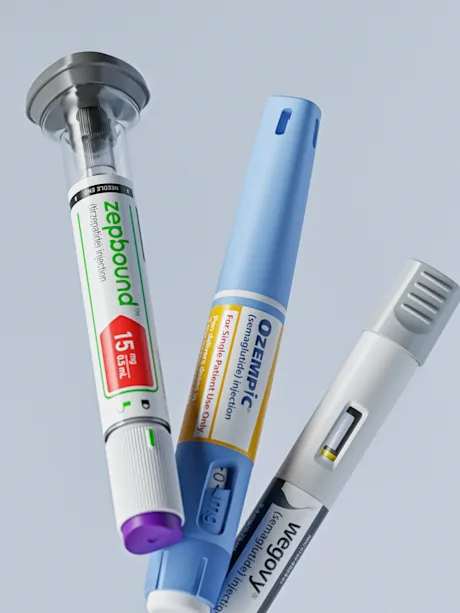Ozempic (semaglutide) Injection

Stimulant-free and non-habit forming
Clinically tested and effective
Helps you feel full faster, longer
Improves the way your body responds to sugars
Ozempic may cause serious side effects including possible thyroid tumors and thyroid cancer. Do not use Ozempic if you or any of your family have ever had a type of thyroid cancer called medullary thyroid carcinoma (MTC) or if you have an endocrine system condition called Multiple Endocrine Neoplasia syndrome type 2 (MEN 2). See Important Safety Information and warnings.
Our Body Program combines Ozempic or similar medication with 1:1 personal coaching and 12 months of curriculum and support—all to help you lose weight and keep it off.
How does Ozempic work?
Ozempic acts like a hormone your body naturally makes to regulate blood sugar and may help support weight loss.
Simple dosing
Take Ozempic as directed using a simple, self-injection pen.
Feel satisfied faster
Ozempic talks directly to the part of your brain in charge of feeling full and satisfied—helping you regulate how much you eat.
Feel full longer
Ozempic slows down how quickly food leaves your stomach—making you feel full faster.
Break the cycle
No more relying on willpower alone—Ozempic helps your body find a new, lower weight to maintain.
Watch Ro Featured On Mad Money With Jim Cramer
With CEO Zachariah Reitano


Get Ozempic medication access and more with the Body Program
Promo: $99 first month, $145/month thereafter
Access to doctor-prescribed GLP-1s
Personal health coaching via video chats and messaging
Personalized weight loss plan
Insurance concierge to help navigate medication coverage
The Body Program cost excludes cost of GLP-1 medication
*You can take your test at any Quest location or purchase an at-home blood collection kit through Ro for an additional cost.If you live in a state where Quest is not available, we’ll automatically send you an at-home collection kit for no charge.
FAQs
What is Ozempic?
Ozempic is a brand-name version of the generic medication semaglutide, which is a type of medication called a glucagon-like peptide 1 receptor agonist. Instead of that tongue-twister of a name, we call these medications “GLP-1s” for short.
Ozempic is FDA-approved for the management of certain symptoms and risks of type 2 diabetes.
Do you prescribe Ozempic for weight loss?
Ozempic is not FDA-approved for weight loss. Ro-affiliated healthcare professionals have the discretion to prescribe a medication off-label if they believe it is an appropriate course of treatment for a particular patient.
How can Ozempic help with weight loss? It acts like a natural hormone your body uses to regulate blood sugar and appetite—key steps in resetting your biological set point to help you maintain a new, lower weight.
See if Ozempic is right for you here.
What is Ozempic’s dosing?
Ozempic dosing starts out low, then gradually increases over the first few months until a steady dose is reached. If prescribed, your Ro-affiliated provider will work with you to find the schedule and dosing that’s right for you.
How do you take Ozempic?
Ozempic comes in a prefilled injection pen that contains multiple doses. If prescribed, you (or someone in your household) will select the prescribed dose, then administer the injection under the skin of your stomach, thigh, or arm once a week.
While a routine injection may sound intimidating, the Ozempic pen uses a tiny needle designed to minimize discomfort. You’ll also receive clear instructions on using the injection pen, and your Ro-affiliated provider can offer additional advice.
How much does Ozempic cost?
How to get Ozempic covered by insurance—it’s a very important question! Well, you can consider us your insurance concierge.
Our partners will work directly with your insurance provider to help with the process of determining coverage for your GLP-1 medication, which is paid for separately from the Body Program. Ro does not accept insurance for the Body Program, which is cash pay only. At this time, those with any form of government healthcare coverage (including programs such as Medicare, Medicaid or TRICARE), whether primary or secondary, are not eligible for the Ro Body Program. These plans typically do not cover the type of medication the Ro Body Program may prescribe. Unfortunately, this means that those on Medicare or eligible for Medicare cannot join the Ro Body Program.
Are there foods to avoid while taking Ozempic?
While a Ro-affiliated provider may offer personalized guidance for each individual, in general, there are no foods to avoid while taking Ozempic. In fact, our Body Program makes a point to avoid labeling any food as “off-limits,” and instead guides you in finding an approach to food that’s both enjoyable and supports your weight loss goals.
However, if prescribed Ozempic, you might choose to avoid certain foods on days that your doses are increased. Some gastrointestinal side effects like nausea may occur when Ozempic doses are increased, so you might find that it’s best to avoid foods that make you feel gassy or bloated on days that you’re increasing your dose.
What are the most common Ozempic side effects?
All medications carry a risk of potential side effects. Ozempic’s side effects are typically mild and often improve within the first few weeks of treatment. When they occur, it’s usually when doses are increased, then tend to improve once a steady dose is reached. Some of the most common side effects include:
Nausea
Vomiting
Upset stomach
Stomach pains
Constipation
Diarrhea
Heartburn
Acid reflux
Belching and gas
Dizziness
Headaches
Fatigue
More severe side effects are uncommon but possible. Serious side effects include:
Thyroid cancer—The FDA has issued its most serious warning (called a BOXED WARNING) that GLP-1s may be associated with a type of thyroid cancer called medullary thyroid carcinoma. So far, this side effect has primarily been seen in laboratory studies using rodents, so the risk to humans has not been determined.
Pancreatitis
Gallbladder disease
Rapid heartbeat
Severe allergy (hypersensitivity)
Low blood sugar
Vision problems (diabetic retinopathy)
Kidney disease
Suicidal thoughts or behaviors
Please see the full Prescribing Information, including the BOXED WARNING, for complete safety information.
Important safety information
What you should know before taking Ozempic.



